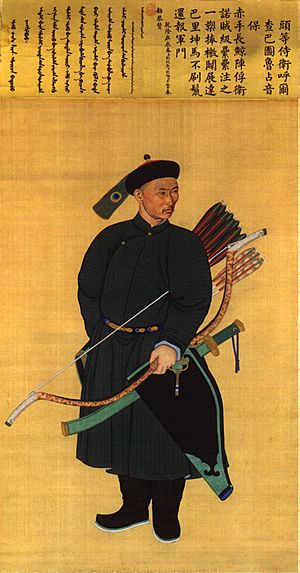Northern Shaolin (martial art) facts for kids

Northern Shaolin (Chinese: 北少林; Pinyin: Běi Shàolín, Cantonese: Pek Sil Lum) is one of the Chinese martial arts and is coming from the Northern Shaolin Monastery in Henan.
Northern styles
Northern styles/Běi pài (北派) feature deeply extended postures—such as the horse, bow, drop, and dragon stances—connected by quick fluid transitions, able to quickly change the direction in which force is issued.
The group of Northern martial arts includes many illustrious styles such as Baguazhang, Bajiquan, Chāquán, Chuojiao, Eagle Claw, Northern Praying Mantis and Taijiquan. Chángquán is often identified as the representative Northern style and forms a separate division in modern Wushu curriculum.
Northern styles exhibit a distinctively different flavor from the martial arts practiced in the South. In general, the training characteristics of northern styles put more focus on legwork, kicking and acrobatics. The influence of Northern styles can be found in traditional Korean martial arts and their emphasis on high-level kicks.
It has been suggested that the presence of high kicks and flying kicks found in Southern styles, in Okinawan martial arts, and hence in modern non-Chinese styles such as karate and taekwondo (and by extension modern kickboxing) are due to influence from northern styles during the first half of the 20th century.
Characteristics
The Northern Shaolin style of kung fu is one of the most prominent traditional northern styles of Chinese martial arts. The northern styles of kung-fu generally emphasize long range techniques, quick advances and retreats, wide stances, kicking and leaping techniques, whirling circular blocks, quickness, agility, and aggressive attacks.
The system teaches empty-hand techniques and weaponry through predetermined combinations, known as forms, routines, or movement of sets. The students learn the basics by practicing the routines until the movements in the routines can be executed naturally based on instinct. Then, two or multiple man sets are practiced to train responses and applications of techniques learned from the sets. The practice sets/routines are not only practical in applications but are also graceful and artistic in nature. The fluidness of the movements combined with acrobatic techniques are trademarks of the Northern Shaolin sets.
The Northern Shaolin style was made famous by the late Gu Yu-jeung. Many legends tell of Gu's feats; according to tales related by his close students, Gu's father was an accomplished exponent of the Tan Tui ("springing leg") form. When he was young, Gu traveled throughout Northern China to learn all the northern kung fu systems. He was renowned for his Iron Palm techniques and the application of the long spear. He organized all his learnings into what is today's Northern Shaolin style.
The Northern Shaolin curriculum of Gu Ru Zhang
| Chinese | Mandarin Pinyin | Cantonese | ||
|---|---|---|---|---|
| Open the Door | 開門 | Kāi Mén | Hoi Moon | open the door |
| Lead the Way | 領路 | Lǐng Lù | Ling Lo | lead the way |
| The Sitting Horse | 坐馬 | Zuò Mǎ | Choh Ma | sit on the horse |
| Pierce the Heart | 穿心 | Chuān Xīn | Cheun Sam | penetrate the heart |
| Martial Skill | 武藝 | Wǔ Yì | Mo Ngai | martial skill |
| Short Strike | 短打 | Duǎn Dǎ | Duen Da | hand to hand combat |
| Plum Flower | 梅花 | Méi Huā | Mui fa | plum flower |
| Uprooting Step | 拔步 | Bá Bù | Boot Bo | pluck the stance |
| Chained Fist | 連環拳 | Liánhuánquán | Lin Wan Kuen | Continuous Fist |
| Pattern Method | 式法 | Shì Fǎ | Sik Faat | knowing the way |

